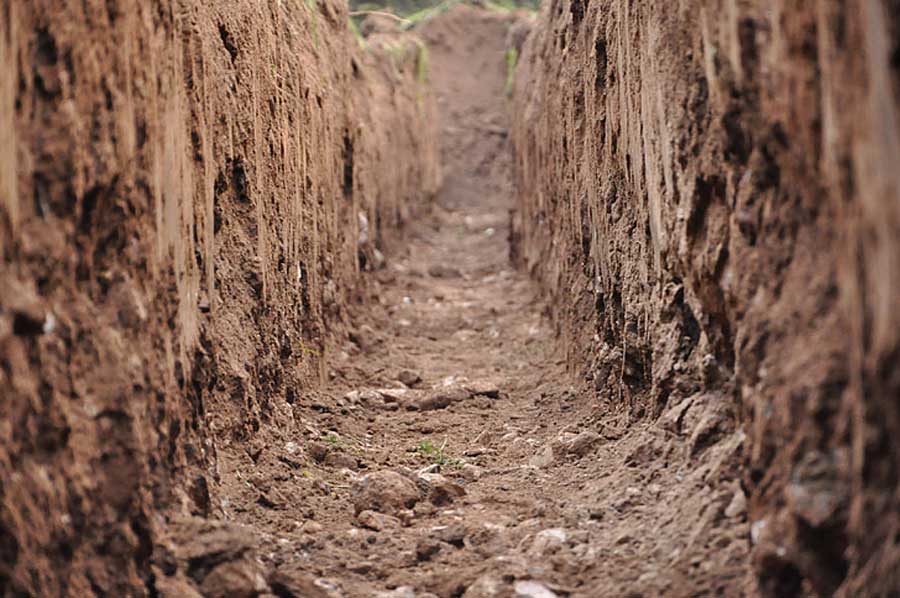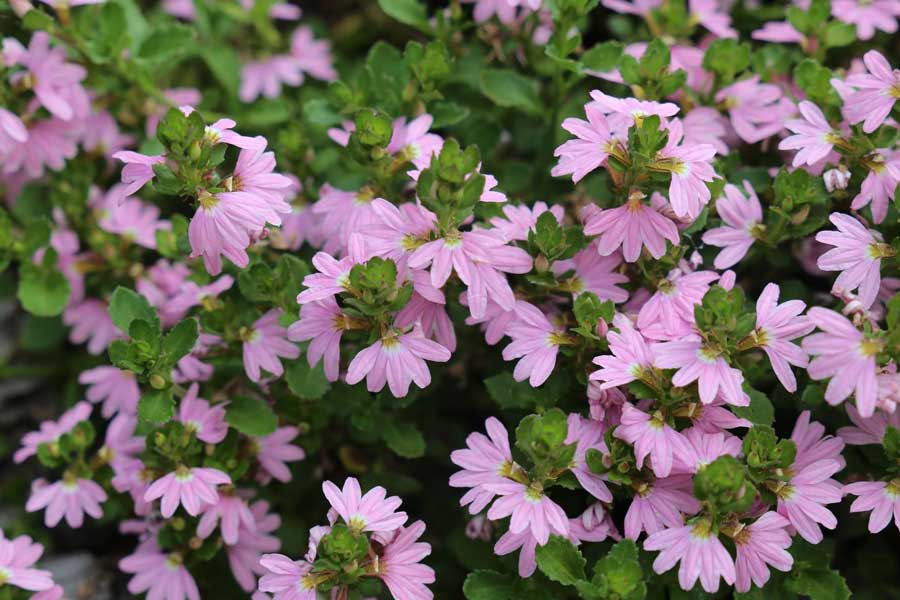Clay soil, often viewed as a gardener’s nemesis, is actually a blessing in disguise. Rich in nutrients and known for its water-retaining properties, clay soil has the potential to be the perfect bed for your plants. However, it does pose certain challenges when it comes to gardening.
These challenges can be easily mitigated by choosing the right plants that are naturally adapted to clay soils, and nurturing it to become the powerhouse that it truly can be.
This is a trench dug in clay-dominant soil.

Understanding Clay Soils
What are Clay Soils vs. Sandy Soils?
Clay soil is a type of soil material that is characterised by its small particle size and its ability to compact easily. It is rich in minerals, which makes it nutrient-dense. However, these tiny particles can stick together, leading to poor drainage and aeration.
Contrast that with sand particles which are large enough to be visible to the naked eye. Sand’s easier to work with than clay, it’s more free-draining and allows for easier root growth, but it loses moisture and nutrients more quickly.
Australia is home to a variety of clay soils, each with unique properties. Some common types include vertosols (cracking clays), chromosols (grey or brown clays), and sodic soils (clays with high sodium content). Each of these soils have different characteristics and require different management strategies.
Pros and Cons of Clay Soils
Clay soils are nutrient powerhouses. They have a high cation exchange capacity (CEC), which means they can hold onto essential nutrients and release them to plants over time. This is why plants growing in clay soils often have lush and vibrant foliage.
However, clay soils also have their drawbacks. Their compact nature means they have poor drainage, which can lead to waterlogged conditions. Additionally, they can become hard and difficult to work with when dry.
The Importance of Choosing the Right Plants for Clay Soils
Adapting to the Environment
Choosing plants that are naturally adapted to clay soils can save you a lot of effort and resources in the long run. These plants have evolved to thrive in these conditions, meaning they are more likely to survive and flourish without the need for extensive soil amendments or special care.
Enhancing Biodiversity and Sustainability
Native Australian plants play a significant role in promoting biodiversity. They provide habitats for local wildlife and help to maintain the balance of our ecosystems. Additionally, because they are adapted to our local conditions, they require less water and fewer resources than exotic species.
Using native plants in landscaping also has environmental benefits. It reduces the need for water, fertilisers, and pesticides, which can have harmful effects on our waterways and wildlife. By choosing native plants for your clay soil garden, you’re not only creating a beautiful garden but also contributing to a more sustainable and biodiverse Australia.
Best Native Plants for Clay Soil
When it comes to gardening in clay soil, the key is to work with nature rather than against it. By selecting native Australian plants that are naturally adapted to clay soils, you can create a flourishing garden with less effort and more satisfaction.
It’s important to note that when we discuss plant suitability at the genus and species level, we’re speaking broadly. When you delve into the cultivar level, plants can behave differently from what you might expect based on their species alone.
For instance, wet feet trials run by Ozbreed have shown that some Westringia cultivars can handle extended periods with wet feet – a common condition in clay soils.
When choosing and specifying plants, always read what the grower or breeder has said about them on their website or a plant tag.
The top Aussie native for your garden bed in clay-dominant soil completely depends on being the right plant for the right place. Factor other considerations outside of soil type into your decision-making process.
What’s the availability of sunlight like? Temperatures? Do you have kids running around that you don’t want stung by bees attracted by your hyper-flowering callistemon?
Eucalyptus spp.
Eucalyptus, or gum trees as they’re commonly known, are a genus of over 700 species of trees and shrubs. Many of these species are accustomed to clay soils, making them an excellent choice for clay-based gardens. Their deep root systems help break up heavy soils and improve drainage. However, due to their size, planting and care are best left to professional arborists.
Acacia spp.
Acacias, also known as wattles, are another group of plants well-suited to clay soils. These hardy plants are drought-tolerant and can thrive in a range of soil types, including heavy clays. Acacias are fast-growing and require little maintenance once established, making them a perfect choice for busy gardeners.
Callistemon spp.
Commonly known as bottlebrush due to their distinctive flowers, Callistemon species are well-adapted to clay soils. These plants are known for their hardiness and can tolerate both drought and waterlogged conditions. They require full sun and well-drained soil to thrive.
Allow me to introduce Candy Burst™ Callistemon spp ‘CNU06’ PBR.

Melaleuca spp.
Melaleucas, or paperbarks, are a diverse group of plants that range from small shrubs to large trees. Many species of Melaleuca are adapted to clay soils and can tolerate waterlogged conditions. These plants are known for their attractive bark and flowers, as well as their ability to attract wildlife.
Lomandra hystrix
Lomandra hystrix, commonly known as mat rush, is a grass-like plant that is highly adaptable to a range of soil types, including clay. This plant is drought-tolerant and can also withstand waterlogged conditions, making it an excellent choice for clay soils.
Native Australian Grasses
Native Australian grasses, such as kangaroo grass (Themeda triandra) and wallaby grass (Rytidosperma spp.), are well-adapted to clay soils. These grasses have deep root systems that help improve soil structure and drainage. They are also hardy and drought-tolerant, making them an excellent low-maintenance option for clay-based gardens.
Banksia spp.
Banksias are a group of plants with over 170 species, most of which are well adapted to the Australian environment. Many species can tolerate heavy clay soils, making them a great choice for clay-based gardens. They are also known for their stunning flower spikes and unique foliage.
Grevillea spp.
Grevilleas are another group of native Australian plants that thrive in a variety of soil types, including clay. These evergreen shrubs and trees are known for their beautiful, spider-like flowers that attract birds and insects. Most species prefer well-drained soil and full sun exposure.
Hardenbergia violacea
Hardenbergia violacea, commonly known as purple coral pea or happy wanderer, is a climbing plant that’s well-suited to clay soils. This hardy plant features vibrant purple flowers and glossy green leaves, making it a colourful addition to any garden. It prefers a sunny or partially shaded position with well-drained soil.
Dianella spp.
Dianella, commonly known as flax lilies, are a group of grass-like plants that are well-adapted to a range of soil types, with some species thriving in clay. These plants feature attractive foliage and colourful berries, making them a popular choice for ornamental gardening. They prefer a sunny or partially shaded position.
Allocasuarina littoralis
Allocasuarina littoralis, also known as black sheoak, is a tree that’s well-suited to clay soils. This hardy plant features needle-like foliage and produces attractive red flowers. It’s a fast-growing species that’s tolerant of a range of conditions, making it a versatile choice for clay-based gardens.
Special Mention: Scaevola (Fan Flowers)
Scaevola, commonly referred to as fan flowers, is a ground-covering plant that is known to thrive in well-drained soils. They’re incredibly beautiful, but what are they doing on this list if they like free-draining soil, though?
Pink Fusion™ is one of the toughest scaevola ever bred, and it can not just survive in the heaviest of clay but thrive. It’ll even give you blooms from autumn, winter and spring to summer even if you aren’t kind to it.
Pink Fusion™ Scaevola spp. ‘PFS200’ (PBR Intended)

Tips for Successful Gardening in Clay Soils
While clay soils can pose certain challenges, with the right knowledge and techniques, you can turn these potential pitfalls into a thriving garden.
Problems with Clay
Clay soils are often misunderstood. While they can be rich in nutrients, they also have their share of problems. One of the main issues with clay soil is its tendency to compact easily, making it difficult for plant roots to penetrate. This can lead to poor plant growth and waterlogging.
Hardened clay is usually identified by its solid, hard surface when dry and its stickiness when wet. Poor clay-dominant soil stability can result in the soil being easily eroded, while sodic soil, which has high sodium content, can impact the movement of water through the soil and potentially harm plant growth.
Improving Soil Structure
Improving the structure of clay soil is possible with the right techniques. Adding organic matter, such as compost or well-rotted manure, can help to break up compacted clay and improve its structure. This enhances the soil’s ability to retain moisture and nutrients, benefiting plant growth.
Gypsum is another great option for breaking up clay soil. However, it should be used with caution. Without the addition of organic matter, gypsum can create impenetrable layers within the soil.
Aeration techniques can also be beneficial. These involve creating small holes in the soil to allow air, water, and nutrients to reach the root zone more effectively. This can be done manually with a garden fork or with specialised equipment for larger areas.
Proper Watering Techniques
Overwatering can be particularly harmful in clay soils due to their poor drainage. It’s crucial to water deeply but infrequently, allowing the soil to dry out between waterings. This encourages plants to develop deep root systems, making them more drought-tolerant and healthy.
Conclusion
Remember, clay isn’t your enemy – it’s a resource. When you understand its properties and how to work with it, clay soil can be the foundation of a thriving garden filled with beautiful native Australian plants.
Choosing native Australian plants that will thrive in clay soil is an effective strategy for working with your soil type. These plants are naturally adapted to the conditions of clay soil, reducing the need for extensive soil amendments or special care.
While clay soils can present certain challenges, embrace them with the right plant choices and gardening techniques to create a thriving, vibrant oasis. Happy gardening!
